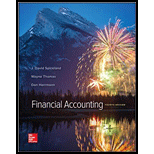
1. a
Calculate the receivables turnover ratio of Company P.
1. a
Explanation of Solution
This is the ratio which analyzes the number of times accounts receivables is collected and converted into cash during the period. This ratio gauges the efficacy of collecting receivables. Larger the ratio, more efficient in collecting receivables. This ratio is determined by dividing net credit sales and average accounts receivables.
Calculate the Receivables turnover ratio of Company P as follows:
Working Notes:
Ascertain the amount of average accounts receivables.
Thus, the receivables turnover ratio of Company P is 18.9 times.
1. b
Calculate the inventory turnover ratio of Company P.
1. b
Explanation of Solution
Inventory turnover:
This is the ratio which analyzes the number of times inventory is sold during the period. This ratio gauges the efficacy of inventory management. Larger the ratio, more efficient the inventory management.
Formula:
Calculate the Inventory turnover ratio of Company P as follows:
Working Notes:
Ascertain the amount of average accounts receivables.
Thus, the inventory turnover ratio of Company P is 14.3 times.
1. c
Calculate the
1. c
Explanation of Solution
Current ratio:
The financial ratio which evaluates the ability of a company to pay off the debt obligations which mature within one year or within completion of operating cycle is referred to as current ratio. This ratio assesses the liquidity of a company.
Formula:
Calculate the Current ratio of Company P as follows:
Working Notes:
Calculate the value of current assets:
Calculate the value of current liabilities.
Thus, the current ratio of Company P is 3.6:1.
1. d
Calculate the acid-test ratio.
1. d
Explanation of Solution
Acid-test ratio:
The financial ratio which evaluates the ability of a company to pay off the instant debt obligations is referred to as quick ratio. Quick assets are cash, marketable securities, and accounts receivables. This ratio assesses the short-term liquidity of a company.
Formula:
Ascertain the acid-test ratio as follows:
Working Notes:
Ascertain the Quick assets:
Thus, the acid-test ratio of Company P is 2.8:1.
1. e
Calculate the debt-equity ratio.
1. e
Explanation of Solution
Debt-equity Ratio:
The debt equity ratio measures the relationship between the amount contributed by creditors and the capital contributed by the stockholders or owners. It indicates the long term solvency position of the company.
Formula:
Ascertain the debt equity ratio as follows:
Working Notes:
Ascertain the total liabilities and
Thus, the debt equity ratio of Company P is 20.3%.
2.
Describe whether one company can have a higher return on assets, while the other company has a higher acid-test ratio, while comparing two companies.
2.
Explanation of Solution
Yes, one company can have a higher current ratio, while the other has a higher acid-test ratio. Due to the higher prepaid expenses and prepaid inventory, the company could have a higher current ratio. When compared to the other current assets, only inventory and prepaid expenses are less liquid, and thus they are excluded in the calculation of acid-test ratio.
The acid-test ratio would always be lower than the current ratio for the same company, since the current ratio comprises all current assets, whereas in the acid-test ratio only cash, current investments and accounts receivables are included.
Want to see more full solutions like this?
Chapter 12 Solutions
Financial Accounting (Connect NOT Included)

 AccountingAccountingISBN:9781337272094Author:WARREN, Carl S., Reeve, James M., Duchac, Jonathan E.Publisher:Cengage Learning,
AccountingAccountingISBN:9781337272094Author:WARREN, Carl S., Reeve, James M., Duchac, Jonathan E.Publisher:Cengage Learning, Accounting Information SystemsAccountingISBN:9781337619202Author:Hall, James A.Publisher:Cengage Learning,
Accounting Information SystemsAccountingISBN:9781337619202Author:Hall, James A.Publisher:Cengage Learning, Horngren's Cost Accounting: A Managerial Emphasis...AccountingISBN:9780134475585Author:Srikant M. Datar, Madhav V. RajanPublisher:PEARSON
Horngren's Cost Accounting: A Managerial Emphasis...AccountingISBN:9780134475585Author:Srikant M. Datar, Madhav V. RajanPublisher:PEARSON Intermediate AccountingAccountingISBN:9781259722660Author:J. David Spiceland, Mark W. Nelson, Wayne M ThomasPublisher:McGraw-Hill Education
Intermediate AccountingAccountingISBN:9781259722660Author:J. David Spiceland, Mark W. Nelson, Wayne M ThomasPublisher:McGraw-Hill Education Financial and Managerial AccountingAccountingISBN:9781259726705Author:John J Wild, Ken W. Shaw, Barbara Chiappetta Fundamental Accounting PrinciplesPublisher:McGraw-Hill Education
Financial and Managerial AccountingAccountingISBN:9781259726705Author:John J Wild, Ken W. Shaw, Barbara Chiappetta Fundamental Accounting PrinciplesPublisher:McGraw-Hill Education





